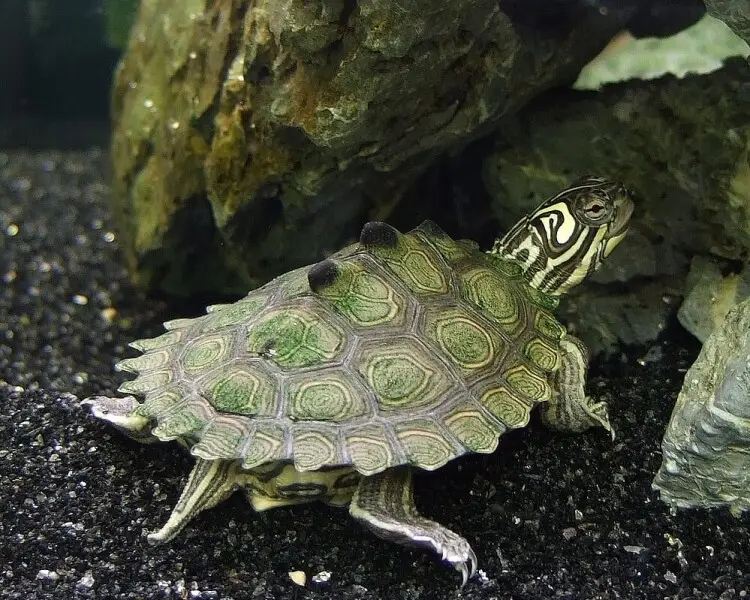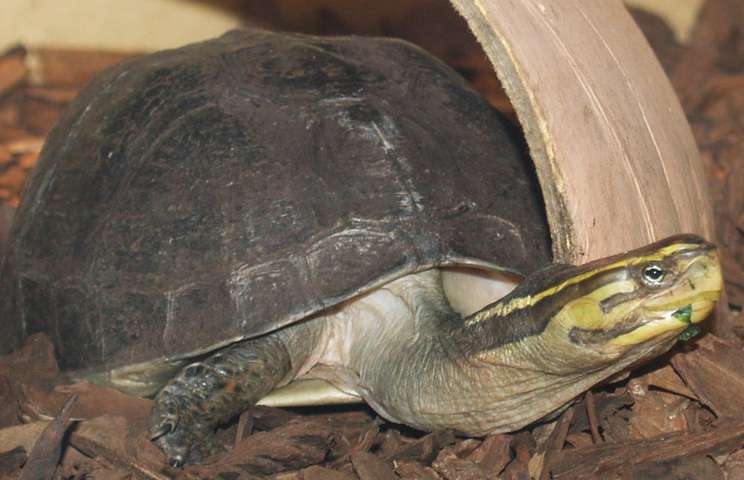
An unusual subspecies of the Map turtle, black-knobbed turtles have projecting keels that resemble knobs with black tips. In addition, these aquatic turtles differ from most other Map turtle species in having gray skin and a darker-green shell. Their heads are dark brown with yellow streaks.
River systems in Alabama and Mississippi are home to black-knobbed map turtles, which are reliant on genuine freshwater ecosystems to live. They mostly consume carnivorous insects, mollusks, and worms in their diet.
Care as a Pet

Housing
The black knobbed map turtle is solely a freshwater turtle, as was already described. It lives in the Tombigbee and Black Warrior river systems’ sand- and clay-bottomed streams. The black knobbed map turtle doesn’t need a lot of space because it is a little turtle. A 25 to 30-gallon aquarium is required for an adult male, whereas a 75-gallon aquarium is required for larger adult females. Since map turtles are active swimmers, a larger tank is always ideal. Additionally, an aquarium can hold two or more map turtles. They can live in the same enclosure as cooters, sliders, and other North American turtles.
Heat
It’s simple to satisfy this turtle’s temperature requirement. The water should be between the low and mid-seventies. The ideal temperature for basking is between the upper 80s and low 90s. Last but not least, the ambient air temperature must be in the low to mid 80s.Use a submersible heater if you have trouble maintaining the recommended water temperature. Given that the temperatures are roughly in line with what one would expect at room temperature, you might not require a heater. Make sure the submersible heater is guarded and that the water doesn’t overheat if you’re utilizing one. To regulate the temperature, use a thermostat like the Inkbird Heating Thermostat. There are various basking lamps available. Ceramic heaters are something I advise. Despite being more expensive, they have a longer lifespan and don’t produce light. This implies that it is operable even at night. To keep an eye on the temperature, use a thermostat like the BN-Link thermostat.
Feed
While most turtles eat both plant and animal matter, water turtles—including the black knobbed map turtle—are often more carnivorous. Give this turtle a diet rich in protein. Don’t overfeed the turtle, though, as this might cause the shell to pyramid and other health issues that could decrease the turtle’s lifespan. Since commercial turtle diets provide all the necessary elements in the proper amounts, I advise making them the mainstay of the turtle’s diet. Additionally, they are supplemented with vitamins and nutrients, so you don’t need to independently supplement the turtle’s food.
To the commercial food, which I suggest should make up around 80% of the diet, add animal protein sources such crayfish, shrimp, feeder fish, earthworms, mealworms (grow your own mealworms), bloodworms, crickets (create a cricket farm), and other insects. Calcium and fiber content are high in leafy greens. These can be given to the turtle every day in any quantity that is required. I recommend romaine lettuce and anacharis. Various suitable plants include hornwort, duckweed, pondweed, water hyacinth, water lilies, frogbit, and other edible sea greens. Feed them more readily obtainable leafy vegetables, such as zucchini, squash, endive, escarole, mustard greens, and others. Never feed meat to mice or turtles. Give the turtle neither fruits nor iceberg lettuce.
Table





